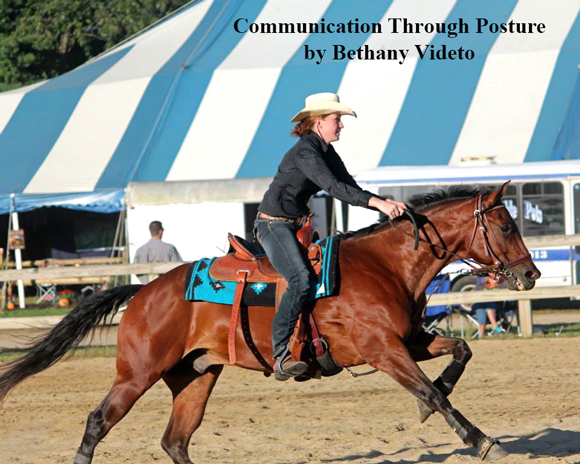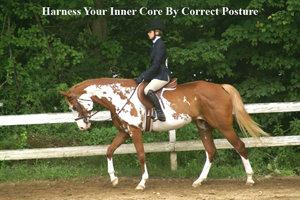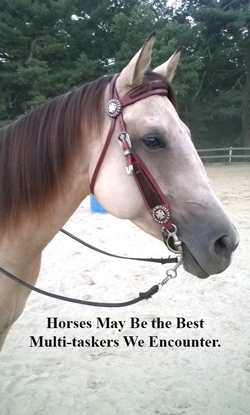Communication Through Posture
by Bethany Videto

Heels down, eyes forward, shoulders in line with your hips, soft elbows, soft hands and breathe. There is a mental check list every rider goes through, at first consciously and over time subconsciously. We do our best to ride with what we are taught is proper posture, but why? Is it just because our instructors tell us to? Or because it is what judges want to see? The horse learns our language and carries our bodies in accordance to silent signals we give and this is what our working relationship is based on. We work hard to find the secrets that help that communication to become more seamless. The end goal is an instant reaction to our queues. No question asked; no hesitation. Our posture is our line of communication while mounted. Posture can be the difference between sitting a buck rather than hitting the ground. It is also the answer to many communication issues, just maybe not the way a rider might think.
The first time you feel a mount round up bringing his back to the saddle, pushing through his hind quarters, dropping into the bridle and softening to the bit is unforgettable. Your horse has adjusted their posture so s/he can work better for you. Suddenly you feel the horse moving underneath you in a much more intimate way, and just as quickly as the connection comes it can leave. Head high, mouth hard, back hollowed and pulling forward off of their forehand. You don’t know that you are feeling all these things at first. A rider has to experience this feeling over and over, but the difference is obvious. The same goes for your horse. What the rider is feeling is the directional change of the energy generated by their mount’s movement. Why is it easier to post a horse trotting when they are round? Because the hind legs are pushing the movement, which means the energy flows from the hoof hitting the ground, up the cannon bone, through the tibia and stifle, to its buttocks and into the seat of the rider, pushing in the direction your hips are already going. Some horses have so much movement in their hind ends that it literally propels the rider back out of the saddle. When the horse’s head is up the energy comes up from the front hoof, through the cannon bone, to the shoulder and into the pommel of the saddle, which pushes the rider back and down. In other words, as you are trying to sit straight and lift your center to post you are fighting against the horse’s movement as it pushes your hips back and your center of gravity goes diving behind you. Now instead of a steady posting position you have to fight not to lean forward with your butt out, or worse not to lean back and balance off of your horse’s mouth.
So in short, all that means is that your horse’s posture affects your ability to ride, work and communicate with him or her efficiently. But communication goes two ways. Think about riding in a circle to the right. Your horse has only your legs and the feel in the bridle to guide them. What happens to your leg and hand if you collapse your center to the right, even just an inch? You right leg presses into your horse’s side a little hard, your heel gets closer to their ribs and the right side of the bit applies just a tiny bit more pressure to the inside of their mouth. Now you are telling your horse to push their ribs out but bring his or her head in. Most horses will compensate for their body over bending by throwing their left (or outside) shoulder out so that they can stay circling for you. You probably don’t even know you are doing it, so you tighten the outside (left) rein and press your left leg and reprimand their naughty behavior; Sometimes gently and other times more harshly. Have you ever stopped to take a deep breath, sit up and relax your shoulders back before blaming the misalignment on your horse? Most riders do not because the collapse is so minor that it is hard to pick up on. We all have a weaker side; it tends to be the side that our horses either over bend to or drop their inside shoulder on. How can they be expected to keep perfect posture if we do not?
Our animals are a reflection us. Their weaknesses are usually our own. Your center collapses and drives your shoulders out of alignment and so they collapse their center and their shoulders go out of alignment. Riders who always look at their hands and their horse’s head (of which many riders are often guilty) lean forward slightly because of the weight of the skull bending their neck. If 5% more body weight is on the front of the saddle, the horse has to carry 5% more weight with their shoulders and they will use less of the hind end to compensate for it. It is the rider’s responsibility to strengthen their posture in the correct position to give their partner the proper circumstances to give the best, most balanced work that they can. The good news is that there are things we can do to help our bodies become more balanced.
 First, strengthen your core! You may have heard this before and knew it was a good idea without every understanding why. I will tell you why. Your core it the supporting structure for your shoulders and legs. It is the only part of your body not somehow in contact with the horse, which means it is suspended in many ways. It has to be strong enough to keep your shoulders stable and help keep your upper body from pulling or leaning on your horse’s mouth, while at the same time assisting your legs to stay in place while the horse moves underneath you. How can your core help you have a better leg position? Test it out, first balance on one leg with loose abs and then try again with slightly contracted abs. You would fall over without your abs to help you stand straight.
First, strengthen your core! You may have heard this before and knew it was a good idea without every understanding why. I will tell you why. Your core it the supporting structure for your shoulders and legs. It is the only part of your body not somehow in contact with the horse, which means it is suspended in many ways. It has to be strong enough to keep your shoulders stable and help keep your upper body from pulling or leaning on your horse’s mouth, while at the same time assisting your legs to stay in place while the horse moves underneath you. How can your core help you have a better leg position? Test it out, first balance on one leg with loose abs and then try again with slightly contracted abs. You would fall over without your abs to help you stand straight.
Second thing you can do to gain an advantage in the saddle is stretch before you ride. And I mean actually stretch. Take 10 minutes to really stretch. This will help you to be more limber and will make your mind more aware of your muscles at the same time. A rider can genuinely feel more of what their muscles are doing after stretching because the nerve endings have been stimulated. You may find you sit heavier on the one side of the saddle and your calf isn’t as extended on the other. Or you may notice that one shoulder is more forward than the other, making it hard for your horse to balance themselves while helping you to balance.
It sounds harsh, but don’t be a lazy rider. It doesn’t feel good to have someone bouncing around on top of you while you do most of the work. Try running down the road with a heavy backpack and you’ll feel it. Riding should tighten your core, your back, and elongate your calf and thigh. This way the horse can have a tighter core, stronger back and elongated gluteal and leg muscles. If they are bracing to absorb the impact of a rider’s body bouncing up and down as they lean left right, forward and back they cannot focus on giving the rider a proper ride. When you stop to realize how much they have to focus on while we are giving commands it becomes quite apparent that horses may be the best multi-taskers we encounter.
around on top of you while you do most of the work. Try running down the road with a heavy backpack and you’ll feel it. Riding should tighten your core, your back, and elongate your calf and thigh. This way the horse can have a tighter core, stronger back and elongated gluteal and leg muscles. If they are bracing to absorb the impact of a rider’s body bouncing up and down as they lean left right, forward and back they cannot focus on giving the rider a proper ride. When you stop to realize how much they have to focus on while we are giving commands it becomes quite apparent that horses may be the best multi-taskers we encounter.
There is a pretty noteworthy bonus to all this extra preparation and work, other than enabling your horse to balance and move more fluidly, you will experience less soreness! Our muscles are designed to generate movement and our joints have evolved to allow range of motion and shock absorption for that movement. Much of the muscle soreness from riding that we attribute to sitting with our legs draping around the sides of a wide creature and squeezing is actually cause by our body being forced to adapt to the movement of the animal below us. Our bodies are used to causing the motion, not reacting to it. When your horse’s movements are choppier, makes sense when you think about it, right? You mount leaning on your leg can also be a cause of major joint and muscle pain. Our legs are not evolved for lifting over 1000 pounds up to shove it back underneath us and unless you have an animal that will adjust themselves with feather weight leg pressure your legs cannot do it alone, they just do not have enough power. Our legs naturally have to look to our hips for assistance, because our hips are attached to our centers, which we have established is our foundation for riding. Every time you have to remind your animal to balance and support themselves you are pulling hips out of alignment. The lower back pain many equestrians feel after riding often stems from their hips not being level any longer. By minimizing the bouncing, lean and sitting at the correct angle for you will look much more stable and be able to walk away without limping.
It’s easy to blame your horse for leaning too much one direction, or diving out. Or to tell yourself that it is the horse’s fault because s/he is argumentative and stiff or refuses to round up and soften due to an obstinate nature. You may well have a mule trapped in a horse’s body, or you may have riding posture that has leaves room for improvement. Next time you’re riding and going through your mental check list, don’t just think about the parts of posture you always pay attention to. Remember to sit up, check your core and really pay attention to the things your body is doing. Your posture may be mis-communicating with your horse, and what you are looking for could be lost in translation.


